
The Internet's Premier Classical Music Source
Related Links
- Latest Reviews
- More Reviews
-
By Composer
-
Collections
DVD & Blu-ray
Books
Concert Reviews
Articles/Interviews
Software
Audio
Search Amazon
Recommended Links
Site News
 Article
Article
The Historical Record
Singers
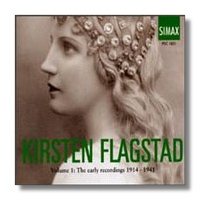
Historical recordings reviewed by Alex Morin
Pride of place in this column belongs to the greatest Wagnerian soprano of the 20th century (and probably the 19th as well), Kirsten Flagstad (1895-1962). Simax has recently released five volumes (PSC 1821/25, 12 discs), covering her entire career and containing her most important and most representative recordings. As you would expect, they include a lot of Wagner, both solo and in remarkable duets with Melchior and others, but they also give us a wide range of other material we don't usually associate with this singer, including large numbers of songs by Grieg, Sibelius, and other Scandinavian composers, lieder by Schubert, Schumann, Brahms, Wolf, and Strauss, and English and American art songs.
Flagstad made her debut at the age of 18 in her native Norway, but her voice developed slowly and she sang mostly light roles in operettas and musical comedies and only in Scandinavia until 1932. By then her voice had greatly deepened and her artistry matured, and her late entry onto the world's stages was spectacular. By the late 1930s, when I first heard her live at the Met, she was internationally famous, but her reputation suffered during WWII, when she was made suspect by her husband's association with the Norwegian Nazis, and it took some time before she was welcomed back to recital stages in the U.S. and elsewhere.
She was a shy, self-contained woman who looked and behaved like a simple hausfrau; she refused to be a prima donna and always insisted her greatest desire was to retire to Norway and spend her life with her husband and children. Watching her knitting placidly or playing solitaire in the wings before she went on stage, observers often wondered whether she really understood what she was doing out there as Brünnhilde or Isolde. The answer was in her performances and is on these discs, in which astounding vocal beauty is combined with great passion and musical insight in deeply felt and deeply moving performances. Hearing her powerful, pure, golden tones ring out effortlessly above the loudest orchestral sound is one of the most electrifying vocal experiences you will encounter. If her characterizations often seemed more stately and restrained than vivid, she made up for it by her musical intelligence, her impeccable intonation and diction, her perfect breath control (which enabled her to produce flawless legato lines), and the radiance, brilliance, ease, and intoxicating beauty of her singing.
The girlish voice we hear in the 1914 recordings in the Simax set is unimpressive, but all the later material is invaluable. She remained essentially a lyric soprano, but the heroic proportions of her mature voice don't allow for the intimacy of communication we expect from lieder; however, even in these songs - recorded when she was almost 60 - her voice is still sumptuous and her artistry is manifest, and she is incomparable in the larger-scaled pieces The early recordings and those from radio tapes are in poor sound but the rest are excellent; many of these selections have appeared in one LP or CD incarnation or another over the years, and for them, these are much the best transfers that have been made. These discs are truly treasurable.
The English contralto Kathleen Ferrier (1912-53) is remembered with great affection by those who heard her in concert, and much of the charm and spirituality of her presence and her singing comes through in her relatively few recordings. She started as a pianist, did not turn to singing until she was 25, and was still expanding her repertory and deepening her artistry when she died of cancer at the age of 41. Her voice was warm and ample, though a bit inflexible, and her interpretations were always naturally expressed and emotionally committed. She was at her best in music that called for breadth and nobility, which she delivered with great sincerity and often with considerable wit. All these aspects of her art are in evidence on a disc from EMI (433473), recorded between 1949 and 1952 in good sound, that includes arias by Purcell, Bach, and Handel, lieder by Wolf, and songs by English composers and arrangers.
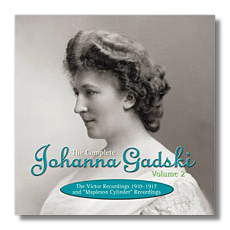
Although the French soprano Emma Calvé (1858-1942) must have been a remarkable singer, on recordings she was not really very satisfying in vocal terms. A recent Marston set (52013) containins recordings from 1902 and 1920, plus some hopelessly inaudible transfers from Mapleson cylinders recorded from the stage of the Met also in 1902. The strength of her low register is apparent, as is her ability to sustain pianissimo high tones, but the set will interest vocal historians more than listeners. The second disc is filled out with 1904 recordings by Cécile Merguillier(1861-1938), described in the program notes as "the last (and the only one to record) of those agile, full-voiced sopranos légers so popular throughout 19th century French opera." Her voice comes through the background noise of these early recordings better than Calvé's, and is interesting - and attractive - as an example of a important vocal style we no longer hear.
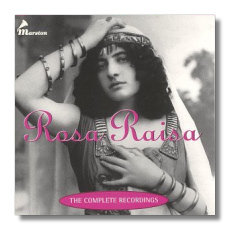
Marston has also issued a three-disc set (53001) containing the complete recordings of Rosa Raisa (1893-1963), who was the leading dramatic soprano at the Chicago Opera during the 1920s and 1930s. She was greatly admired in her time (by Toscanini, among others, for whom she was the first Turandot) for her effortless flow of sound, her easy high notes, and her vivid stage presence, but little of that appears on these discs, where she seems constrained and dispassionate.
Still another Marston set (52011) gives us the complete recordings of soprano Adelina Patti (1843-1919) and baritone Victor Maurel (1848-1943); the latter contains the same selection as a Pearl disc issued some years ago, but in better sound. Both were among the greatest singers of the second half of the 19th century, and both lived long enough to make recordings in the early 1900s, but the age of the singers and the recordings lessen our listening pleasure.
Marcella Sembrich (1858-1935) was famous at the turn of the century as a coloratura soprano and, after she retired from the stage, as a recitalist; Romophone earlier brought out her recordings from 1904 to 1908 and now (81027) we have those from 1908 to 1919, plus some relics from cylinders made from 1900 to 1903. She certainly had a good voice, clear and accurate in tone, but she was overshadowed in her lifetime by the likes of Melba and Tetrazzini, and her recordings are not nearly as entertaining as theirs.
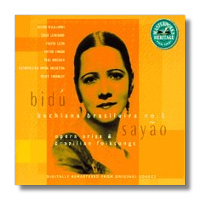
A better case can be made for the Brazilian soprano Bidu Sayão (1902-99), some of whose opera arias and songs are on a Sony Masterworks Heritage disc (62355). She made her New York debut in 1935 and sang at the Met until 1951, taking on a wide range of coloratura and lyric parts. She was petite, chic, and vivacious, and was at her best in soubrette roles; her bright, pure tones and impeccable diction made her particularly effective as Manon, Mimi, and Susanna in Marriage of Figaro. This disc presents her in pretty good sound, in arias and songs by French composers like Gounod, Debussy, and Ravel, as well as her most famous recording, Villa-Lôbos's Bachiana brasiliera 5, and a group of Brazilian folk songs arranged by Braga that are inimitably idiomatic and colorful.
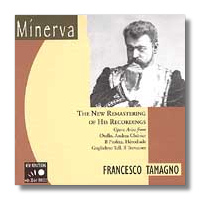
Francesco Tamagno (1850-1905) was among the most famous of all tenors before Caruso, and he lived just long enough to make a few recordings between 1903 and 1905; they are collected in reasonably good transfers on Minerva MN-A68. The selections include the arias for which he was most famous, especially from Otello (Verdi chose him for the première performance) and from operas by Meyerbeer, Massenet, Giordano, and Rossini. He had a huge, heroic voice with a somewhat metallic quality, seamless over two octaves and especially strong and secure in its upper register. Here and there on this disc one can hear a trace of the gentleness and subtlety that were said to characterize his interpretations, but for the most part he seems to be simply standing there shouting into the recording horn, and the result is almost overpowering - and very exciting. Not for those who love sweet sounds, perhaps, but interesting and valuable to collectors of great vocalists.
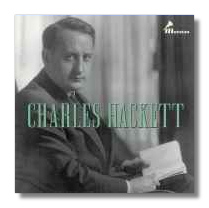
Another rediscovery is the under-rated lyric tenor Charles Hackett (1887-1942), whose Columbia recordings between 1922 and 1928 (plus one from 1912 and another from 1937) appear on Marston 51005. He was the first American tenor to achieve an international reputation, praised for his singing in Milan, London, Buenos Aires, Chicago, and at the Met. I dimly remember him in his Chicago days as a workmanlike tenor of no great distinction, but this disc shows him to have been considerably more than that. His voice was clear, firmly centered and evenly produced, with effortless high notes; he sang with intelligence and musical understanding, for example in the two arias from Massenet's Manon presented here. In a group of English-language songs, his pronunciation is stilted and he lacks McCormack's ability to infuse real feeling into their bathos, but still his voice is very beautiful.
Copyright © 1999, Alexander J. Morin












